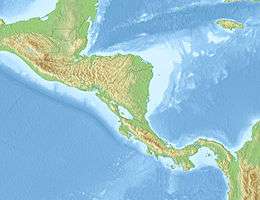1992 Nicaragua earthquake
 | |
| Date | September 2, 1992 |
|---|---|
| Origin time | 0:16 |
| Magnitude | 7.7 Mw[1] |
| Depth | 45 km (28 mi) |
| Epicenter | 11°44′31″N 87°20′24″W / 11.742°N 87.340°W[1] |
| Type | Thrust |
| Areas affected | Nicaragua |
| Tsunami | Yes |
| Casualties | at least 116 killed[1] |
The 1992 Nicaragua earthquake occurred off the coast of Nicaragua at 6:16 p.m. on September 2. Some damage was also reported in Costa Rica. At least 116 people were killed and several more were injured. The quake was located in an active zone of stress and deformation. It created tsunamis disproportionately large for its surface wave magnitude.
Tectonics
The 1992 Nicaragua earthquake was the first tsunami earthquake to be captured on modern broadband seismic networks.[2] The initial surface wave magnitude was estimated at 7.2.[3] The shock occurred on the subduction interface between the Cocos and Caribbean Plates, an active zone of stress and deformation,[3] and due to the absence of sediment on the ocean floor off Nicaragua, the slip propagated up-dip all the way to the trench bottom, a creator of large tsunamis.[2] This occurrence of slip of a plate interface filled with soft subducted sediments caused the rupturing process to be slower than the average subduction zone thrust earthquakes[2] while the focus of the earthquake was much shallower than the typical subduction zone earthquake.[3]
Damage and casualties
The first shock of the earthquake occurred at 0:16 GMT and was followed by several strong aftershocks.[4] The quake was most widely felt in the Chinandega and León departments of Nicaragua, though it was also felt elsewhere in Nicaragua at Crucero, Managua and San Marcos and at San José in Costa Rica.[1] It was the strongest seismic event to hit Nicaragua since the earthquake of 1972.[4]
At least 116 people were killed, most being children sleeping in their beds,[5] with more than 68 missing and over 13,500 left homeless in Nicaragua.[1] At least 1,300 houses and 185 fishing boats were destroyed along the west coast of Nicaragua.[1] Total damage in Nicaragua was estimated at between 20 and 30 million U.S. dollars.[1]
According to the Augusto César Sandino Foundation, the most affected were "inhabitants of small poor communities who live from diverse subsistence activities. Their houses, located beside the sea, were almost entirely destroyed. These people have lost their livelihoods, poor peasants who grow basic grains for their own consumption in marginal areas, and fisherpeople who have lost their fishing equipment, boats, storage sheds and warehouses. Their already extreme poverty has been exacerbated."[6]
Tsunami
Most of the casualties and damage were caused by a tsunami affecting the west coasts of Nicaragua and Costa Rica, and it was one of three tsunamis to occur within a span of six months.[5] Runup heights were measured shortly after the earthquake[7] and reached heights of up to 9.9 meters, though the average height was 3 to 8 meters.[8][9] The tsunami was disproportionately large for its surface wave magnitude, or Ms,[2] and the duration of the rupture process was 100 s, unusually long for its size.[8] The moment magnitude was 7.6, larger than the 20-s Ms of 7; this Ms–Mw difference is a characteristic of tsunami earthquakes.[2] Tide gages were set up at Corinto and Puerto Sandino, which showed an impulsive tsunami originating 61 minutes after the earthquake.[8] It ran inland 1,000 meters to Masachapa,[1] the hardest hit major town of all, with 9 fatalities.[4]
Relief efforts
From the onset of the disaster authorities provided initial assistance.[4] President Violeta Chamorro stated in her speech to her nation on September 2, 1992 that no international assistance was needed.[4] However, the Red Cross did assist in some operations while the National Civil Defence carried out much of the relief operations, with wounded people being transported to the Hospital Leon and Lenin-Fonseca Hospital.[4]
See also
References
- 1 2 3 4 5 6 7 8 Significant Earthquakes of the World in 1992 United States Geological Survey
- 1 2 3 4 5 Kanamori, Hiroo; Kikuchi, Masayuki (1993). "The 1992 Nicaragua earthquake: a slow tsunami earthquake associated with subducted sediments". Nature. 361 (361): 714–716. Bibcode:1993Natur.361..714K. doi:10.1038/361714a0.
- 1 2 3 Pararas-Carayannis, G. (2007). "The Earthquake and Tsunami of 2 September 1992 in Nicaragua". Archived from the original on 17 May 2008. Retrieved 2008-06-09.
- 1 2 3 4 5 6 Nicaragua Earthquake/Tsunami Situation Reports 1 – 7 United Nations Department of Humanitarian Affairs
- 1 2 Folger, Tim (1992). "Waves of destruction – tsunamis – Cover Story". Discovery. FindArticles.com. Retrieved 2008-06-06.
- ↑ Hinman, Pip (1992-09-09). "Aid for Nicaragua". Green Left.
- ↑ Kikuchi, M.; Kanamori, H. (1995). "Source characteristics of the Nicaragua Tsunami Earthquake of September 2, 1992" (PDF). Pure and Applied Geophysics. 144 (3–4): 441–453. Bibcode:1995PApGe.144..441K. doi:10.1007/bf00874377.
- 1 2 3 Satake, Kenji (1995). "Linear and nonlinear computations of the 1992 Nicaragua earthquake tsunami". Pure and Applied Geophysics. Springer. 144: 455–70. Bibcode:1995PApGe.144..455S. doi:10.1007/BF00874378.
- ↑ Fernández-Arce, Mario; Alvarado-Delgado, Guillermo (2005). "Tsunamis and Tsunami Preparedness in Costa Rica, Central America" (PDF). ISET Journal of Earthquake Technology. Paper No. 466. Indian Society of Earthquake Technology. 42 (4): 203–212. ISSN 0972-0405.
External links
- Nicaragua Earthquake/Tsunami Sep 1992 UNDHA Situation Reports 1 – 7 – UN Department of Humanitarian Affairs
- Historic earthquakes – United States Geological Survey